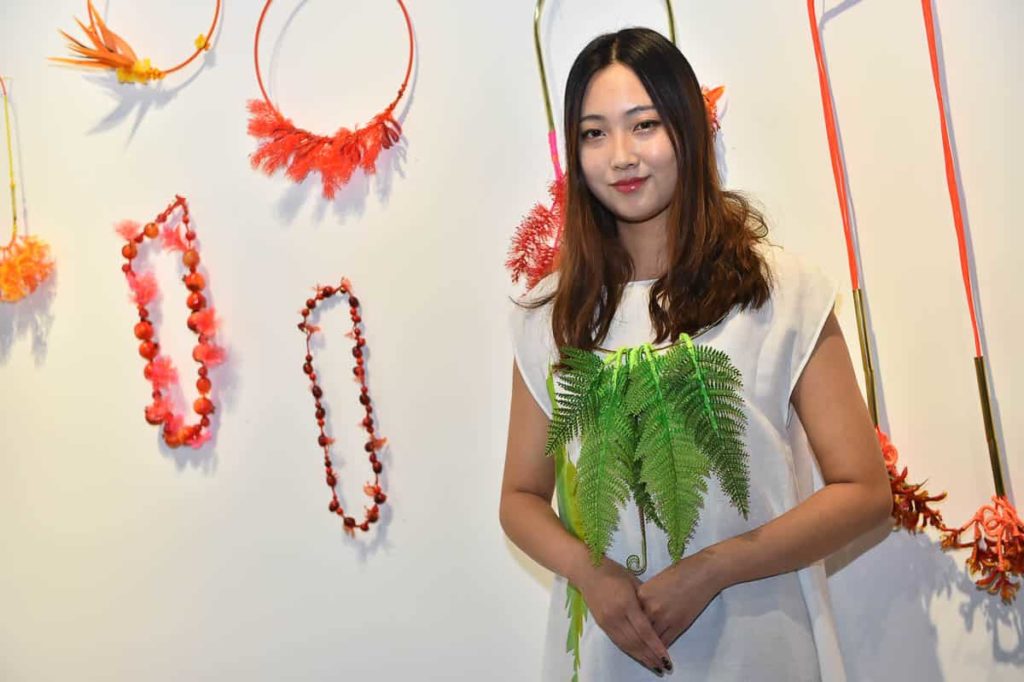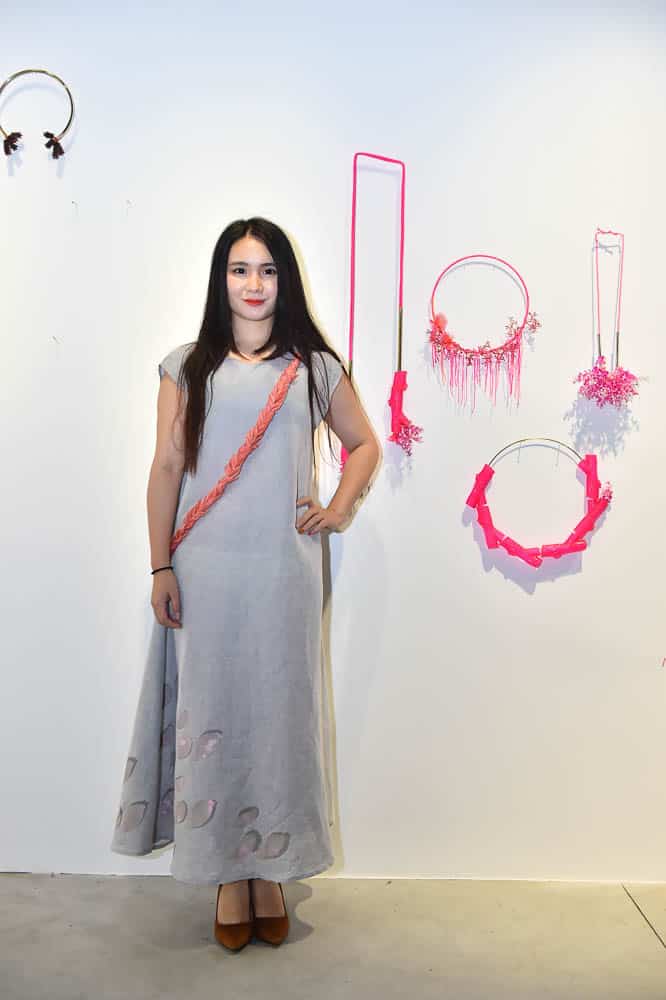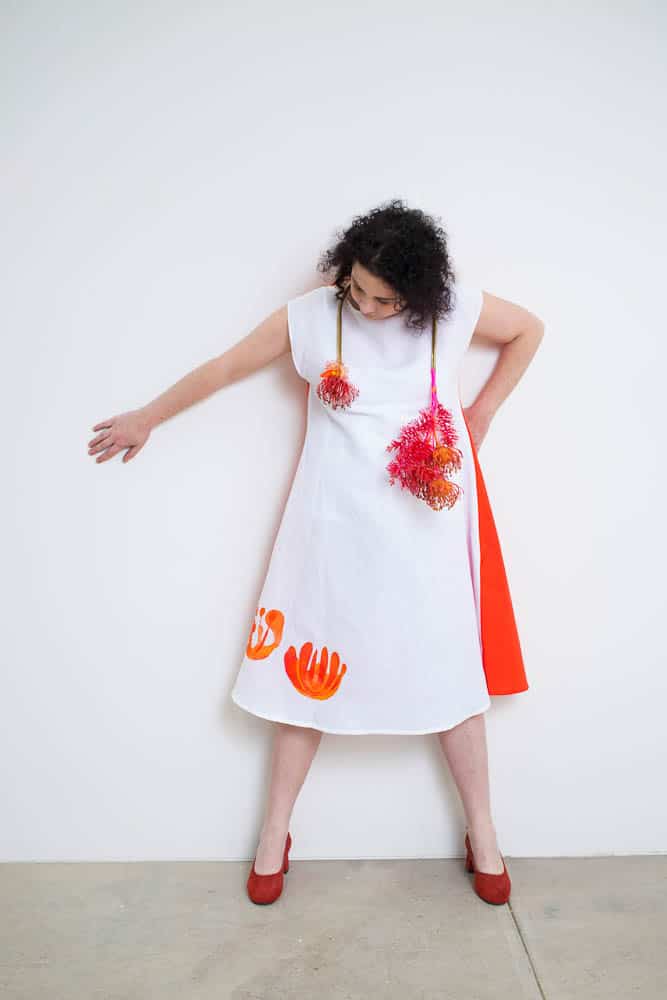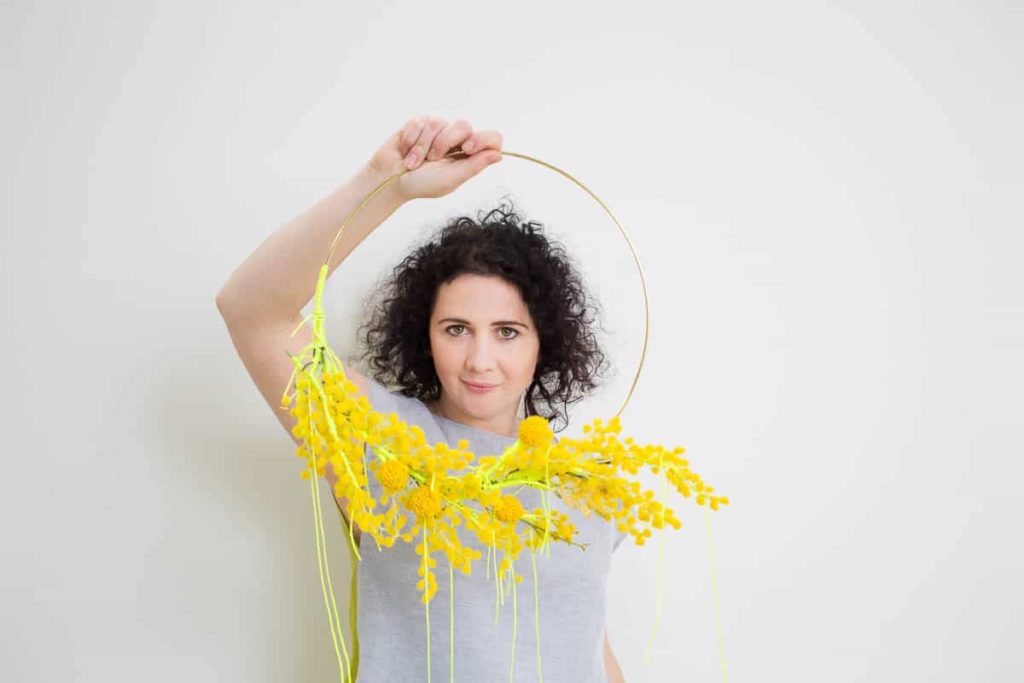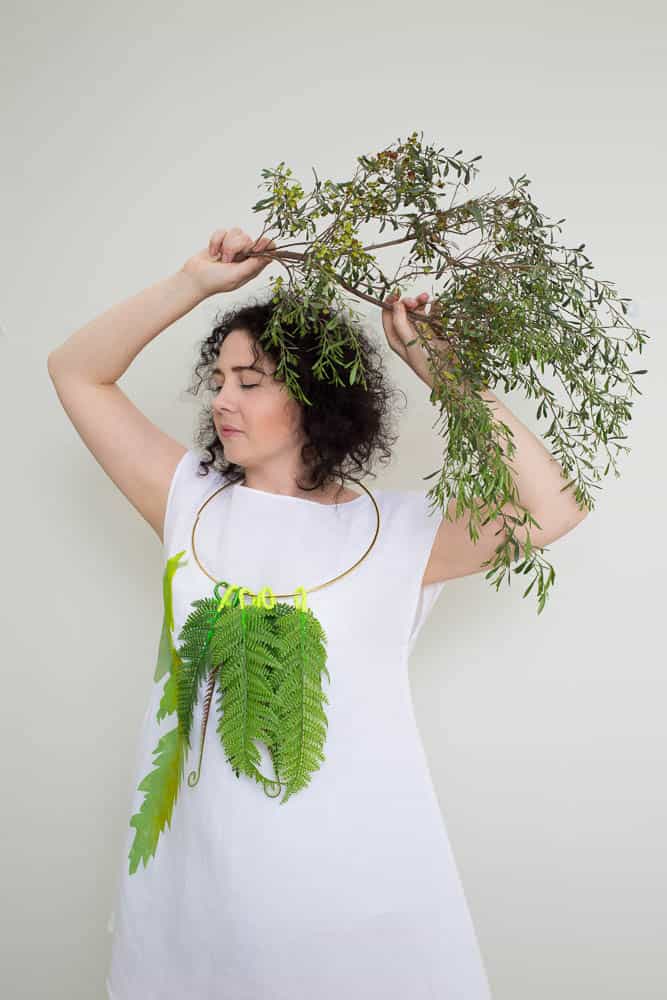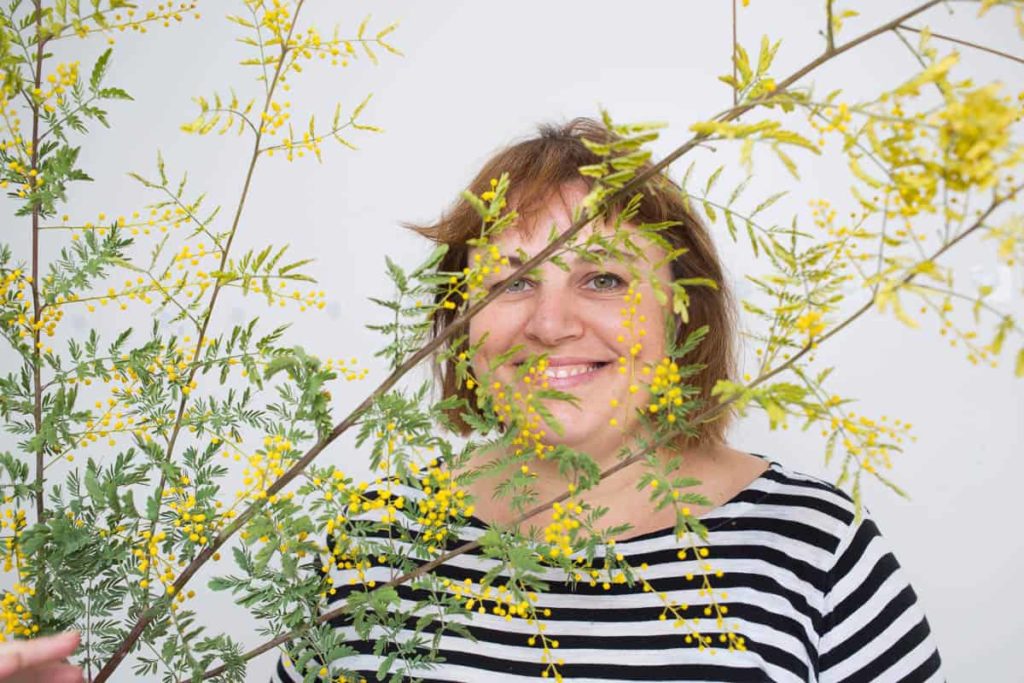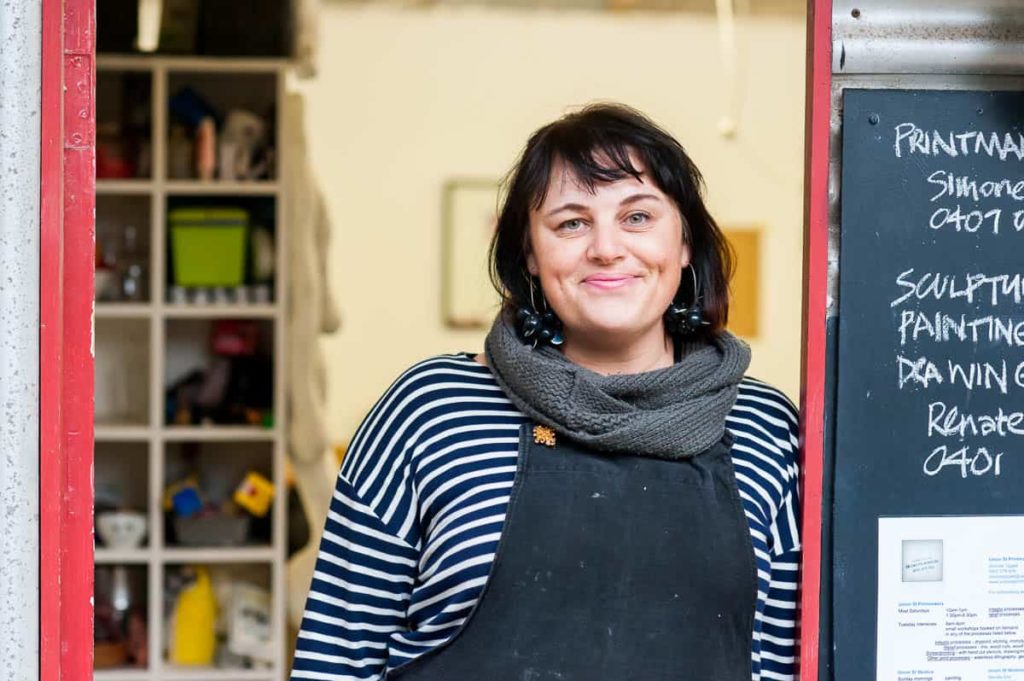- Lauren Simeoni, Protea neckpiece, 2017, artificial foliage, brass, beads, thread, paint; Protea dress, long white + red Linen-cotton, Hand cut stencil print, one-off, photo: Craig Arnold
- Lauren Simeoni, Wattle lei, 2017, artificial foliage, metal ring, thread, paint; Lauren Simeoni, Wattle dress, Short grey + chartreuse linen-cotton, hand cut stencil print, one-off, photo: Craig Arnold
- Lauren Simeoni, Fern lei, 2017, artificial foliage, metal ring, thread, paint; Fern dress, Short white Linen-cotton, hand-cut stencil print, one-off, photo: Craig Arnold
- Lauren Simeoni, Cactus neckpiece, 2016, artificial foliage, brass, beads, paint; Cactus dress, 2017, short grey Linen-cotton with chartreuse appliqué, hand cut stencil print, one-off, photo: Craig Arnold
- Lauren Simeoni, 2017; photo: Craig Arnold
- Lauren Simeoni, 2017. photo: Aise Dillon
Lauren Simeoni works from the corner of a repurposed church. Traces of the building’s past life are everywhere. There are high ceilings, chipped paint and an abandoned cross hanging like a ghost from the rafters. Stepping into Gate 8 Workshop in Adelaide’s western suburbs feels a bit like trying to clutch at a memory that has already half escaped you. But now, inhabited by a collective of five contemporary artists and the sprawl of their ongoing work, the structure is a lively buzz of activity.
Tucked away at the back, Lauren’s studio is a magpie’s nest of eclectic objects. Baskets overflow with plastic fruit and strings of fake flowers are draped across the walls. Transparent drawers reveal a colossal archive of beads and other knick-knacks, all sorted carefully by colour. A traditionally trained jeweller, Lauren studied in gold and silver smithing before stumbling across her now signature style by accident. It started when she and Sydney jeweller Melinda Young started sending each other plastic foliage in the mail.
“Originally, when Mel and I started using artificial foliage, it just happened to be that because it was fun and easy to post. Strangely though, we’ve both become quite obsessed with it,” she says.
The result is an ongoing body of work called Unnatural, Naturally. What originally started as a playful gesture between friends soon took on a life of its own, and now both jewellers use elements of fabricated nature in their practice. Lauren’s neckpieces come in all colours of the rainbow, ranging from the brightest green to brilliant red. Plastic plants and flowers are layered with beads and semiprecious stones in an unlikely medley of materials. The pieces prompt a visceral response: immediately you feel compelled to run your fingers over them, to unclasp each one and drape it over your neck. It feels more akin to wearing a small sculpture than a piece of jewellery.
Lauren is freshly back from a trip to China where she exhibited her work at San W Gallery in Shanghai, an opportunity made possible by a partnership between Guildhouse and the Yiwei Art Foundation. The exhibition is called Lei Over, a bon mot alluding to both a short stay in a foreign place and a decorative wreath. She speaks softly about the rationale behind this title, while handing me every piece she sees my eyes linger over, encouraging me to try on her creations.
“I make neckpieces, but I always think of them as leis or garlands. The act of putting them on is a positive ritual. Even if it’s for sadness, it’s acknowledgement and respect and welcoming. The act of giving a garland is a handshake between two people. Pacific cultures have always done it, Indigenous Australians too. I think that one of the most basic, essential, raw pieces of adornment you can do is to string objects together and make a neckpiece,” she says.
The exhibition also saw Lauren foray into printmaking, a skill she fine-tuned during a Guildhouse LimberUp mentorship with the established printmaker Simone Tippett. After this instruction, she felt compelled to play with tradition and start printing directly onto fabric. She layered stencils and created monochromatic patterns in much the same style as her jewellery. Working with local dressmaker Rosie Hannam lead to a series of garments with bold natural prints, each complementing a different neckpiece. The layering of materials and textures lends richness to the final product.
Similarly, the Shanghai Lauren describes to me is one of contrasts. A city of lush, manicured parks tucked between steely high-rise apartments that often materialised overnight. Weather that toggled between tropical and overcast on a whim. Even the streets surrounding her apartment were in a constant state of flux, reinventing themselves multiple times a day to cater to the needs of their inhabitants.
“There were these big markets spanning a couple of blocks that would completely transform a couple of times a day. In the morning the stalls would sell vegetables, eggs, live chickens and geese. There were these big troughs of live crabs, fish and eels all flailing about. You’d walk past and just see them being gutted. Then a couple of hours later everything was swept and hosed away, and those same shops would have other jobs that they would do. Maybe the partner in the family would be mending, or fixing motorbikes. At night when we’d walk home they would be cooking their meal outside, often sharing with kids running around. Then finally, beds would come out from under tables and the families would be converting their little space into a living area,” she says.
When she wasn’t indulging in the sights and sounds of the city, Lauren was busy at work. She spent most days at the studio installing her pieces in preparation for the exhibition. Local students had the opportunity to tap into her creative wisdom at one of her many workshops, where she encouraged them to fashion jewellery from any number of unlikely items. They also donned her designs in a fashion parade that celebrated the opening night of Lei Over at San W Gallery.
It seems like the perfect creative pilgrimage for someone who is so smitten by detail. To Lauren, every item is precious and the minutiae of everyday life acts as an endless source of wonder. Her creative process is a mystery even to her. She usually takes an intuitive approach, letting the material and her surroundings shape the work.
“I could very well decide what I’m going to do then be distracted by a detail in my everyday life that changes things. It could be as simple as walking the dog when I notice the way a fence is attached to the gate. I’ll think the wrapping technique with the wire is quite nice and decide to use it. I’ll often mix up semi-precious stones with gold and silver but you wouldn’t really notice it. I give each material the same weight in value. I almost find the plastic more valuable because I never know if I can get the same plant again.”
This attention to detail is reflected in bold neckpieces like Wattle lei, which incorporates the twining of bright yellow thread to a brass ring, reminiscent of Australian flora growing through a suburban fence. Lauren’s work is certainly a nod to the bright, open and unashamedly brash character of our native wildlife. Both have strong compositions and layer rich patterns. Both flourish in the face of constraint.
Back in the studio, surrounded by a museum-like archive of the strange and beautiful, I can’t help but feel like we’re sitting in an artificial rainforest. The sweltering heat of early November is only just kept at bay by concrete walls. Lauren’s shrine to shape and colour spills out from every crevice. It’s easy to get distracted as your eyes feast on the smallest details.
“I think if I didn’t have imagery I’d be stuck, because I’m not a words person. That’s why I do what I do. Bounty is what I’m interested in. It’s the wealth of the harvest, the collection. I’m trying to satisfy the greediness of my mind.”
We sip on soda water with fresh lime and quietly contemplate our surroundings for a moment. Despite their best efforts, words so often fail to speak a language that our eyes know by heart. Afternoon light filters through the lofty windows and I feel for a moment that we might actually be somewhere deep in the wilderness, even though suburbia is waiting for us outside the door. Then laughter from the next studio breaks the silence and we can’t help but laugh along, shifting back to the echo and buzz of the old church.
Author
 Katharine Ahern is an emerging writer based in Adelaide with a particular interest in creative people and the arts. She studied Journalism and Professional Writing at the University of South Australia and currently writes for Guildhouse.
Katharine Ahern is an emerging writer based in Adelaide with a particular interest in creative people and the arts. She studied Journalism and Professional Writing at the University of South Australia and currently writes for Guildhouse.

